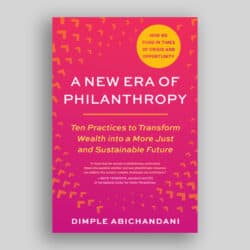Published by Canadian School Boards Association/L’Association canadienne des commissionslconseils scolaires, Ottawa, pp. 135, $25
REVIEWED BY JOYCE FORSTER
Associate Editor, The Philanthropist
Deep in the heart of every volunteer who has ever tried to raise money for a good cause lies the conviction that professional fundraisers know secret formulae that are guaranteed to produce outstanding results with little effort.
Unfortunately this myth is just that-a myth. There is no magic that will ensure effortless and successful fundraising. There are, however, a number of good ideas that can be adopted by the energetic amateur with a fair chance of success as a reward for diligence and good planning and this little book outlines 37 tried-and-true projects that can be undertaken by even small groups.
The Canadian School Boards Association, publisher of the book, describes itself as “a national nonprofit organization that aims to give school boards across Canada the opportunity to share experience and expertise in providing high-quality elementary and secondary school programs”. The Association believes that “fundraising is a fact of life in the entire school system” but reminds enthusiastic parents that such efforts should produce “extras” like band uniforms, not the requirements of basic education which the taxpayers are duty-bound to provide.
Chapter 1, “In the beginning…”, sets the stage and defines a few terms but is primarily useful for its warning of the need for ethical principles and guidelines in any fundraising activity. With the “wages of sin” at an all-time high it is always tempting to quiet the uneasy conscience with the excuse that at least some of that money should be going to good causes. Volunteers heading down that slippery slope should not be surprised when the pickets and reporters arrive.
Chapter 2 outlines a basic planning process, Chapter 3 shows how to “put it all together”, and Chapter 4 outlines necessary public relations initiatives.
All of this information is useful but it’s at Chapter 5 that the volunteer’s heart begins to beat a little faster. Designed for those who must raise several hundred to several thousands of dollars in a fairly short time, it lists and describes an astonishing array of projects ranging from silent auctions to various “thons” and totalling 37 in all. Very few require much in the way of startup funds but all demand a substantial input of volunteer effort. Needless to say, not all of these events will suit all small organizations but there would seem to be something for everyone. An aside: one suggestion is a Phantom Event, designed to tap the pockets of those who would rather give money than time. Such nonevents work quite well the first time (particularly if you’re dealing with a fairly affluent market). Sometimes they work well a second time. Unfortunately sometime between the third and fifth approach they collapse and do not even cover mailing costs. Trust me on this.
Experienced fundraisers may be inclined to skim Chapter 5 and put it aside, sighing “been there, done that” but, before dismissing this impressive list, it might be a good idea to remember that it really isn’t necessary to keep reinventing the wheel. The original model continues to work quite well.
Chapter 6 offers some basic but useful information about seeking sponsors. Chapter 7 is a once-over-lightly glance at community events.
Chapter 8 is an “Event-Ability Quiz” which, in my opinion, would be worth the price of the book all by itself. Failure to pass the quiz should save a good deal of grief and provide all concerned with a call to arms or, in some cases, a clear indication that the project is not viable. Quite aside from the information it reveals, it forces fundraisers to answer a number of questions that volunteers often avoid in the misplaced belief that such matters “will take care of themselves”. As an additional benefit, a clear demonstration that some area is falling down on the job is a lot more palatable from an impersonal test than from other committee members, which may be the unpleasant alternative.
Information about capital campaigns provided in Chapter 9 is perfectly sound but I question the value of including it in this type of book. Unless your goal is so modest that it can be reached by an appeal by friends to a few well-to-do supporters, raising big bucks is best left to professionals. Volunteers will still have to work, and work hard, but professional direction will be more likely to ensure that their hard work produces the desired results.
Chapter 10 has some commonsense advice about the care and stroking of both donors and volunteers. “A” may be for “ask” but the saying that “them as asks, gets”, which is the essential message of the book, is going to lead to very short-term success unless it is followed pretty smartly by “five, six, seven, eight, who do we appreciate?”
Chapter 11 tells how to measure success or failure. The results of your efforts will certainly give you a clear idea of both but there are intangibles, not reflected in campaign goals or totals, that must also be considered before final judgment is passed.
The Conclusion might be summarized as “just do it!”, a piece of sound advice that would seem obvious were it not that many well-intentioned fundraisers find it easy to embark on yet another feasibility study or needs assessmentanything to delay the awful moment when one has to actually get out there and “ask”.
A final section lists a number of useful resources including printed material, organizations (addresses and phone numbers provided), multimedia and continuing education sources.
Eleven chapters plus a Conclusion and Resource list may sound daunting but it should be noted that, except for the Chapter 5 discussion of 37 events, the average chapter is just two or three pages long. The book is attractively bound in a red spiral binding, lightened by a generous use of red in graphics, offers a couple of delightful cartoons by Ben Wicks and, in general, is so easy to read that it can be skimmed in little more than an hour.
In an age of multi-million-dollar lotteries and half-billion-dollar capital campaigns it is easy to overlook the needs of the volunteer fundraisers who give charity its human face and whose multitude of small projects provide so many of the good things that go to make up a genuinely “civil” society. This book should be in the resource library of any volunteer group who must raise funds as well as the libraries of those who advise them. It is available from:
Canadian School Boards Association
130 Slater Street, Suite 350
Ottawa, Ontario, KIP 6E2
Telephone: (613) 235-3724
Fax: (613) 238-8434
e-mail: admin @cdnsba.org
$25 per copy
What Are You Doing With My Money?: Solutions to Important
Issues Facing Charities
By Ken Dick
Published by Harmony Printing Limited, Toronto.
REVIEWED BY BETSY CLARKE
Bouza & Associates Inc., Ottawa
The title of Ken Dick’s book reflects a question asked more and more frequently in recent years by donors. What are charities doing with the more than eight billion dollars given to them annually?
If one reads the horror stories in any number of newspapers and magazines, the answer might well be “something unethical”. A recent article in Macleans magazine suggests that many charities are not disbursing their receipted donations according to Revenue Canada guidelines. The National Baptist Convention in Milwaukee has discovered that more than one million dollars was diverted from its treasury by top staff. The Ontario Government has published a pamphlet entitled Phoney Charities: Scams for all Seasons.
The title suggests that this book is timely, written to ensure that if a donor does ask the question, the charity is well-prepared to answer. Unfortunately, the contents indicate that the book is a little off the mark. Instead of answering the question posed in the title, the discussion includes topics such as termination of employees and staff benefits, all of which are important to efficient running of an organization but not necessarily the kind of information a donor requires when seeking information about the disposition of a donation.
The tone of the book detracts from its credibility. Much of the material is anecdotal, based on the everyday experiences of the author in his particular work environment. The extensive use of the personal pronouns/, me and my lacks the credibility of more broadly-based experience. Much of the advice is prefaced with “I think”, which again raises concern about credibility.
Because the author was a senior manager with World Vision Canada, many of the situations that he draws on to illustrate his points are based on the specific experience of a large, international religious organization. It is doubtful that many organizations today, even those smaller than World Vision Canada, would not have more sophisticated systems. There is also information which could seriously mislead the unwary: for example, giving board members a tax receipt if they pay their own expenses to meetings. Revenue Canada requires an exchange of cheques before a tax receipt can be issued.
If the reader is able to move beyond the expectation that the title question will be answered, and if a very personal writing style is not troubling, the book offers some solid features. For a prospective board member, the advice in the chapter on Boards makes good sense. For example, the book recommends that before accepting a board position prospective members should ask about directors’ and officers’ liability insurance and find out the policy regarding paying for meeting expenses and the relationship between board and staff. Advice on staff recruitment is also sound. Another section outlines the reasons why policies are important to the efficient operation of an organization.
Not wanting the readers of this review to conclude that there is nothing in the book to satisfy donors’ questions, the chapter on Accountability must be mentioned, but its place late in the sequence of chapters tends to negate its impact and the chapter subtitle “Guilt Trip” detracts from the positive aspects of accountability. However, little in the chapter is as negative as the subtitle suggests. The author writes about the various constituencies and groups to which an organization is accountable, including donors. Also included are references to professional organizations such as the Canadian Institute of Chartered Accountants which have developed appropriate reporting principles and standards.
The final chapter deals with the cost of doing business in a charity and what a reasonable ratio of fundraising costs to funds raised might be. This is an area often questioned by donors and the guidelines here offer good basic advice.
Liberal interjections of humour make the book an easy read; it is not a weighty treatise on fundraising. It is, however, a reasonably good general reference text for smaller organizations and especially for volunteers and support staff. Perhaps its greatest value lies in the fact that it raises the question that is asked much more frequently now than when the book was first published (1977) and, even with its shortcomings, it does provide many sensible answers in an easy-to-read format.
This book is available from:
Ken Dick Management Consultants
P.O. Box 202
Streetsville, ON L5M 2B8


